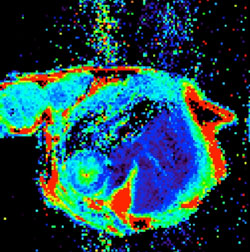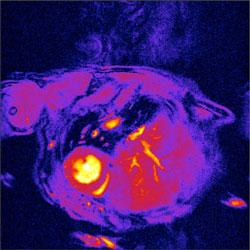| Posted: Nov 11, 2015 | |
Gold-manganese nanoparticles for targeted diagnostic and imaging |
|
| (Nanowerk Spotlight) Imagine the possibility of non-invasive, non-radiation based Magnetic Resonance Imaging (MRI) in combating cardiac disease. Researchers at the Savannah River National Laboratory (SRNL) are developing a process that would use nanotechnology in a novel, targeted approach that would allow MRIs to be more descriptive and brighter, and to target specific organs. | |
| An MRI is a non-invasive procedure that uses a superconducting magnet to align the hydrogen protons in the body. Magnetic resonance imaging is one of the most powerful imaging and diagnostic techniques used to visualize the internal structure of the body. Contrast agents, or dyes, are used to help provide different signals and improve the captured magnetic image. Of the contrast agents, one can be extremely toxic, while overexposure to another can lead to Parkinson’s disease. A third agent has limitations that can create “black holes” in the image. | |
| By using nanoparticle-based MRI positive contrast agents, you can specifically target different tissues or organs, you can control active component loading, and you can generate bright or hyperintense anatomical view of the tissue. | |
| Researchers at SRNL have discovered a way to use multifunctional metallic gold-manganese nanoparticles to create a unique, targeted positive contrast agent (Journal of Nanoparticle Research, "Manganese–gold nanoparticles as an MRI positive contrast agent in mesenchymal stem cell labeling"). SRNL Senior Scientist, Dr. Simona Hunyadi Murph, first thought of using nanoparticles for cardiac disease applications after learning that people who have survived an infarct exhibit have up to a 15 times higher rate of developing chronic heart failure, arrhythmias and/or sudden death compared to the general population. | |
  |
|
| The left image is a T1 map. The right image is a high resolution image. The blue areas indicate uptake of Au-Mn. (Image: Simona Hunyadi Murph, Savannah River National Laboratory) | |
| But, why manganese and/or gold? It is well known in the research community that intracellular Ca2+ is a central regulator of cardiac contractility and viability of the heart. However, calcium cannot be used to monitor to assess Ca2+ dynamics during a myocardial infarction. As a result, a surrogate biomarker that can enter cells via voltage gated calcium channels enabling functional studies of brain and heart was needed. Manganese is the best candidate for the job. Mn2+ has similar chemical properties to Ca2+, has additional paramagnetic properties (responds to the magnetic field) and is an important metal for human health, being absolutely necessary for development, metabolism, and the antioxidant system. | |
| Since we were interested in conducting targeted diagnostic studies for imaging/monitoring site systems a “solid platform/vessel” in the form of gold nanoparticles was selected to control and tailor the Mn release and exposure. Because the gold portion of these nanoparticles strongly absorbs light in the near infrared, these particles can be remotely heated via near-infrared light thereby releasing the “Mn payloads” remotely. The absorbed near-infrared light can be emitted as heat or fluorescence. | |
| This procedure is fast, feasible, and uses a low power, low cost laser. This procedure also presents no risk for other bodily organs due to the wavelength regime used (infrared) for which light has a maximum penetration depth in tissues. Moreover, these gold-coated vehicles have the potential to be used for the controlled delivery of a wide range of other substances including genes, pesticides, cosmetics and food stuffs. The elastic properties of gold nanoparticles allow one to also see cells light up under microscopes when bound to nanoparticles. | |
| Why nanoscale materials? At the nanoscale is where the basic building blocks of matter are established and where fundamental properties are defined. At the nanoscale, the physical, chemical, and biological properties of materials differ in fundamental ways from the properties of individual atoms, molecules or bulk matter. | |
| By controlling the growth of atoms one precisely tailors their characteristics. For example, gold nanospheres display a beautiful red and not the classical “gold” color when suspended in aqueous media. | |
| Moreover, gold nanorods appear green, blue or brown depending on the length of the nanorod demonstrating that different size and shape nanoparticles have different properties. While gold metal is extremely stable to oxidations in bulk (which is one of the reasons to use it as jewelry) they become extremely active in the nanometer regime. | |
| Gold nanoparticles of diameter ~3 nm are no longer “noble” and unreactive, but can catalyze chemical reactions. Also, as the nanoparticle sizes decreases their surface area increases. The more surface are the more active points and faster chemical reactions. | |
| Nanometer scale metallic wires show extraordinarily high combinations of strength, stiffness, and ductility relative to bulk materials. They are able to absorb and scatter light in the visible region of the electromagnetic spectrum which can be exploited in biological optical imaging and sensing applications. | |
| Without question, nanotechnology will revolutionize the future of technology. The development of functional nanomaterials with multi-detection modalities opens up new avenues for creating multi-purpose technologies for biomedical applications. | |
| The improvements in MRI performance developed by SRNL and Medical College of Georgia scientists can provide information at the anatomical, molecular, and cellular levels, thus broadening the application of MRI from imaging to early diagnosis and therapeutic medicine. | |
| Even though the idea of tiny robots navigating through humans and repairing damaged tissues is still science fiction, the future of nanotechnology to help achieve this goal looks promising. The possibility of finding new and intriguing nanomaterials that can cure disease, help us explore and/or live in space, make us live longer and healthier lives, increase communications between people around the world, and discover new energy supplies is exhilarating. | |
|
By Simona Hunyadi Murph, Ph.D., ([email protected]), Savannah River National Laboratory
|
|
|
Become a Spotlight guest author! Join our large and growing group of guest contributors. Have you just published a scientific paper or have other exciting developments to share with the nanotechnology community? Here is how to publish on nanowerk.com. |
|
